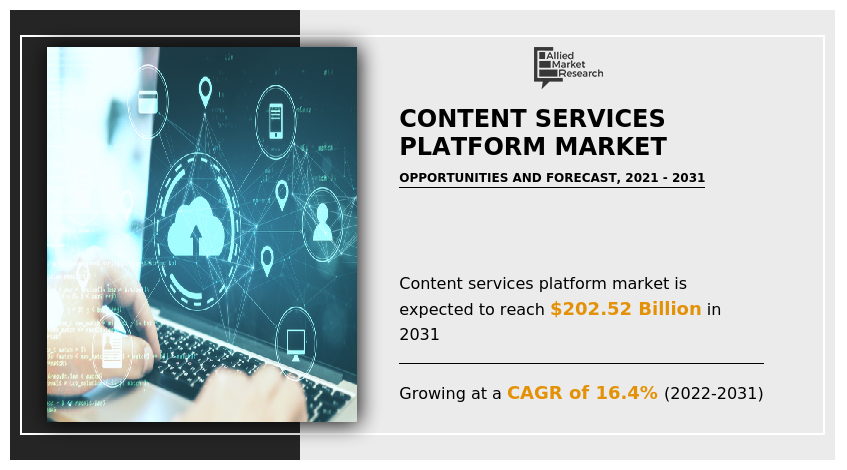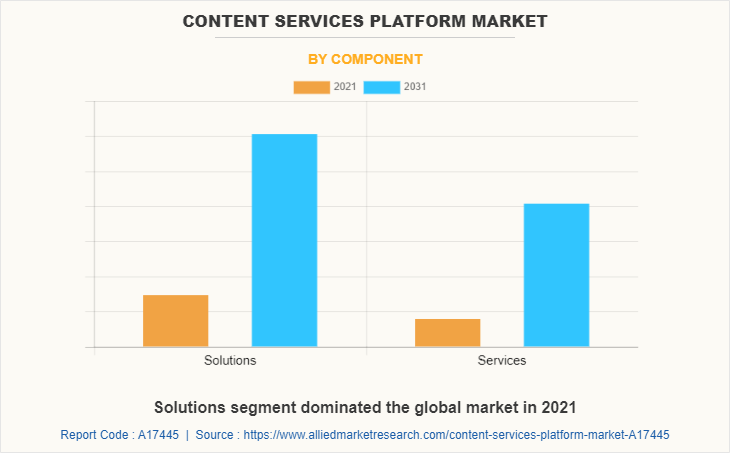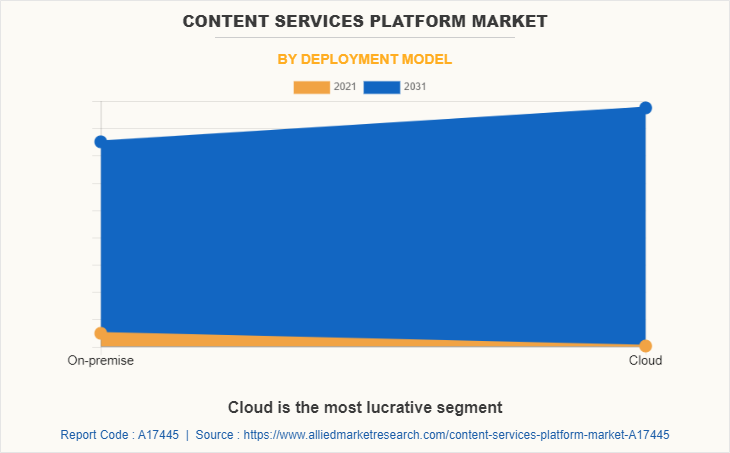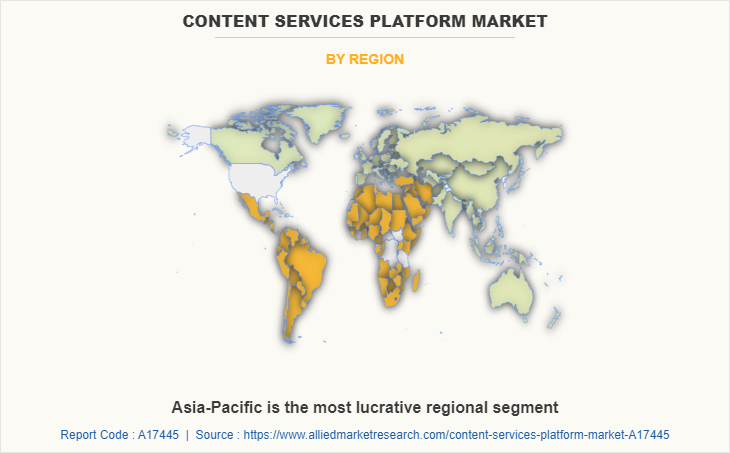Content Services Platform Market Size & Insights:
The global content services platform market was valued at USD 45.08 billion in 2021, and is projected to reach USD 202.52 billion by 2031, growing at a CAGR of 16.4% from 2022 to 2031.
Content services platforms is a software that enables users to create, collaborate, share, and store text, video, and audio content. It is a set of services and micro services, exemplified either as separate applications or an integrated product suite. Content services platforms share common repositories and APIs, to exploit diverse content types and to serve multiple customer and numerous use cases across an organization. It has the ability to manage and store the metadata of digitized content and file sync and transfer from a single platforms. Content services platforms were developed to fulfil the surge in need for content by huge corporations, as they are designed to enable individuals, teams, and workgroups across the enterprise to effectively access content data. Content services platforms (CSPs) are integrated platforms that support digital business and transformation by providing content-focused services, repositories, APIs, solutions, and business processing tools. Sometimes these platforms offer prebuilt solutions for vertical and horizontal content processes including case management, legal issue management, and contract administration.

Further, the digital transformation has been at the top of all the IT agendas for the past few years. However, the number of companies reaping its full benefits are small. AIIM found that close to 80% of organizations thought that the digital transformation was essential or very important for their business. However, the number of companies that are reaping the full technologies benefits is small. This factor is expected to drive the adoption of content services platforms during the forecast period.
The content services platform market is segmented into Component, Deployment Model, Organization Size and Industry Vertical.By component, it is bifurcated into solutions and services. By deployment model, it is divided into on-premises and cloud. By organizational size, the market is segmented into SMEs and large enterprises. By industry vertical, the market is categorized into BFSI, IT and telecom, government, healthcare, education, transportation, media & entertainment, energy and utilities, and others. Region wise, it is analyzed across North America, Europe, Asia-Pacific and LAMEA.

On the basis of component, the solutions segment dominated the content services platform industry in 2021, and is expected to maintain its dominance in the upcoming years. Moreover, the increased demand for enhanced consumer service across a wide range of verticals is attributable to the growth of the company. Furthermore, by combining several technologies, these solutions are capable of constructing a complete analysis of the data. Content services platforms frequently integrates with digital analytics and social analytics software or has similar features. For instance, in May 2020 - OpenText announced Pathos Clinical Solutions, an independent, full-service clinical laboratory, has selected OpenText EMR-Link for comprehensive EMR integration, Computerized Physician Order Entry (CPOE), and secure connectivity to clinicians.

On the basis of deployment model, the on-premise segment dominated the Content services platform market share in 2021, and is expected to maintain the dominance in the upcoming years. It is because surged the amount of data transfer between business parties and has increased the risks of cyber-attacks and data losses. However, the cloud is expected to witness the highest growth rate during the content services platform market forecast period, owing to the fact that cloud deployment is cost-effective. It does away with the requirement for an IT department.

On the basis of region, the North America dominated the content services platform industry in 2021, and is expected to continue this trends during the forecast period, owing to the increase in usage of content services software in BFSI, IT and government sector to improve businesses and the customer experience, is projected to provide lucrative opportunities for the content services platforms market. However, the Asia-Pacific region is expected to witness highest growth in the upcoming years, owing to the fact that the technology environment in Asian countries is expanding, particularly in sectors such as healthcare, retail and BFSI.
Top Impacting Factors:
Factors such as cloud migration, microservices and the use of hybrid and distributed cloud, robotic process automation (RPA) and hyperautomation, and artificial intelligence (AI) and machine learning (ML) primarily drives the content services platform market growth. However, administering user-generated content may hamper the market growth to some extent. On the other hand, increasing adoption of end-to-end cross-platforms solutions is expected to provide lucrative opportunities for the market growth during the forecast period.
Cloud migration, microservices and the use of hybrid and distributed cloud
Prior to last year, the shift to the cloud was steadily increasing. In response to COVID-19 there was a significant surge in companies implementing cloud strategies to best support newly remote and distributed workforces. While planning their go-forward strategies to maintain remote working environments, many organizations found technology gaps that could have been addressed with the right cloud IT strategy. This year, I expect companies to learn from the lessons in 2020 and move forward with cloud-first strategies to support business, employees and customers. By removing technology maintenance and IT infrastructure, organizations create new efficiencies allowing information services professionals to focus on application creation, adoption and optimization.
Additionally, organizations are increasing their adoption of microservices. This trend further supports utilization of cloud solutions delivering the desired scalability and flexibility of a container driven deployment without the additional overhead and orchestration of superfluous workloads.
Robotic process automation (RPA) and hyperautomation
Content services platforms have always excelled at automating workflow processes to achieve increased efficiency and effectiveness. As new innovative technologies are developed, it is important organizations consider the impact they can have when integrated into the larger IT strategy. Take RPA for example. While no longer considered cutting-edge, in 2021 RPA will be in its prime to help businesses further automate labor-intensive processes utilizing bots. RPA can bring some quick wins for organizations, automating mundane, repetitive tasks. Acting as an automation extension within a content services platforms, RPA adds a layer of intelligent automation to further drive digital transformation within an organization. The trajectory of RPA continuing within an intelligent automation theme, with the future encompassing self-leering bots and integrations with artificial intelligence (AI) especially around machine learning. In this prediction, systems and bots learn from previous scenarios and decisions to handle rules-based processes independently.
Key Benefits for Stakeholders:
- This report provides a quantitative analysis of the market segments, current trends, estimations, and dynamics of the content services platform market analysis from 2021 to 2031 to identify the prevailing content services platform market opportunities.
- The market research is offered along with information related to key drivers, restraints, and opportunities.
- Porter's five forces analysis highlights the potency of buyers and suppliers to enable stakeholders make profit-oriented business decisions and strengthen their supplier-buyer network.
- In-depth analysis of the content services platform market segmentation assists to determine the prevailing market opportunities.
- Major countries in each region are mapped according to their revenue contribution to the global market.
- Market player positioning facilitates benchmarking and provides a clear understanding of the present position of the market players.
- The report includes the analysis of the regional as well as global content services platform market trends, key players, market segments, application areas, and market growth strategies.
Content Services Platform Market Report Highlights
| Aspects | Details |
| By Component |
|
| By Deployment Model |
|
| By Organization Size |
|
| By Industry Vertical |
|
| By Region |
|
| Key Market Players | Microsoft Corporation, DocuWare, Oracle Corporation, Hyland Software, Inc., OpenText Corporation, Paper Alternative Solutions Inc., Fabasoft AG, Adobe, Inc., Kyocera Corporation, International Business Machine Corporation |
Analyst Review
In accordance with the insights by the CXOs of leading companies, the global content services platforms market is projected to expand at a rapid pace during the forecast period, due to the increase in demand for cloud-based content services platforms among organizations. Content services platforms is expected to experience significant growth during the forecast period, owing to increase in need for digital content with the proliferation of online marketing & online customer relationship. Moreover, constant development of the e-commerce industry fuels the demand for content services platforms to store, manage, create, and distribute digital content through online channels. In addition, increase in adoption of cloud-based content services is expected to boost the content services platforms market growth in the future. However, high initial costs of implementation and lack of awareness to implement the right solution for the specific needs among small and medium-sized enterprises (SMEs) hinder the growth of content services platforms industry.
In the digital era where computers and smartphones are monopolizing communication and life, there seems to be a comparatively less growth rate of traditional marketing than digital marketing. Through studies it has been observed that the content services platforms sector has benefited from the pandemic COVID-19's rapid spread. In an effort to retain efficiency, organizations all around the world have switched to content services platforms. Non-essential personnel are now permitted to work remotely for an extended period of time in several developed nations, including Europe and the U.S. Moreover, the previous year has seen a rapid increase in the number of cyberattacks. This has forced companies to adopt security-first thinking. The service provider is now working considerably harder to secure its clients' service infrastructure. In addition, the data breaches have resulted in the loss of important client data and an exponential spike in prices. In the financial services and insurance industries, 88% of all cyber incidents were motivated by money, according to Verizon's 2019 Data Breach Investigations Report (DBIR).
Enterprises and organizations all around the world have abruptly shifted to content services platforms in an effort to maintain productivity because physical interaction is no longer an effective means of communication in light of social distancing initiatives brought on by the COVID-19 epidemic. In addition, a lot of industrialized countries, including Europe and the U.S., are increasingly mandating workers at non-essential companies to work remotely for an endless period of time. Together, these elements support the market's expansion.
The Content services platforms market size is estimated to grow from $45.08 billion in 2021, and is projected to reach $202.52 billion by 2031
The Content services platforms market is projected to grow at a compound annual growth rate of 16.4% from 2022 to 2031.
Adobe Inc., DocuWare, Fabasoft AG, Hyland Software Inc., International Business Machine Corporation (IBM), Kyocera Corporation, Microsoft Corporation, Open Text Corporation, Oracle Corporation, Paper Alternative Solutions Inc.
On the basis of region, the North America dominated the content services platforms industry in 2021.
Increasing adoption of end-to-end cross-platforms solutions is expected to provide lucrative opportunities for the market growth during the forecast period
Loading Table Of Content...



